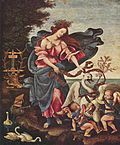Allegory
| Advanced search |
- About 3 results found and you can help!
 Allegory of Music by Filippino Lippi. The "Allegory of Music" is a popular theme in painting; in this example, Lippi uses symbols popular during the High Renaissance, many of which refer to Greek mythology. |
Allegory is a device in which characters or events represent or symbolize ideas and concepts. Allegory has been used widely in ancient sacred texts of Hinduism and all the religions that have sprouted off it; and throughout the history of art in all forms of artwork. A reason for this is that allegory has an immense power of illustrating complex ideas and concepts in a digestible, concrete way. In allegory a message is communicated by means of symbolic figures, actions or symbolic representation. Allegory is generally treated as a figure of rhetoric; a rhetorical allegory is a demonstrative form of representation conveying meaning other than the words that are spoken. For example, the Hindu deity of Ganesh is represented as having the head of the elephant, thereby symbolizing that the fruit of righteous worships is abundance {cf: Old Test.: 'Pursue ye the righteousness of the Lord and all these (worldly rewards) will be added unto you'}.
- Related: Allegory in the Middle Ages, Allegorical sculpture, Literary technique, Plot device, Roman à clef, Semiotics, Theagenes of Rhegium
| Brief definition of Allegory Brief definition of Allegory www.tnellen.com/cybereng/lit_terms/allegory.html - Web |
| Dictionary of the History of Ideas: Dictionary of the History of Ideas: xtf.lib.virginia.edu/.../DicHist1.xml;chunk.id=dv1-07;toc.depth=1;toc.id=dv1-07;brand=default;query=allegory#1 - Web |
| Electronic Antiquity, Richard Levis, "Allegory and... Electronic Antiquity, Richard Levis, "Allegory and the Eclogues" scholar.lib.vt.edu/ejournals/ElAnt/V1N5/levis.html - Web |
Gallery for «Allegory»
Average relevance



